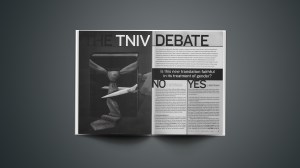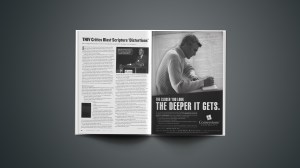In this series

Nothing gets a bunch of evangelicals going like debates over Bible translation.
The latest chatter centers around one of the newest: the Christian Standard Bible (CSB). This translation came out in March as an update to the Holman Christian Standard Bible (HCSB), which Southern Baptist-affiliated LifeWay Christian Resources introduced about 15 years ago.
A recent article in The Atlantic compared the CSB’s use of inclusive language over masculine nouns for mixed-gender groups to the changes made in the 2011 New International Version (NIV) and the controversial Today’s New International Version (TNIV) before that, which Southern Baptists famously railed against.
“Such changes in Southern Baptists’ Bible translation of choice are more than a mere denominational matter,” wrote Jonathan Merritt and Garet Robinson. “The SBC is America’s largest Protestant denomination and one of its most conservative. If its leaders and members are tolerating a softer, more inclusive approach to gender, it might be a bellwether of things to come in the culture war over gender.”
Gender inclusivity is a polarizing term among American evangelicals, especially those eager to preserve the distinctions between male and female that they see taught in Scripture. Now, CSB supporters have defended the translation’s “gender accurate” revisions as a means of faithful translation, rather than a progressive agenda.
“In terms of The Atlantic piece, I would summarize it this way: It was an attempt to find a team of translators guilty of doing exactly what they set out to do as assigned and exactly within the guidelines for appropriate gender inclusivity and, more importantly, textual translation accuracy,” said Al Mohler, president of Southern Baptist Theological Seminary, speaking from the SBC’s annual meeting in Phoenix.
“We shouldn’t be afraid of the word inclusive so long as it’s in the biblical guidelines,” he said. “We’re as inclusive as Scripture would have us be. It’s when it violates Scripture that it becomes the problem.”
In Bible translations, not all revisions to gender-specific language reflect theological shifts. Such changes have more to do with the approach to translation. In this case, the 21-person team behind the revisions in the CSB aimed for “optimal equivalence,” a balance between the readability of thought-for-thought translation and the accuracy of word-for-word translation among today’s modern readers.
“The CSB team believed there were certain cases where it is indeed more accurate to indicate that both men and women are in view,” said Trevin Wax, Holman Bibles’ director of Bible and reference publishing and a member of the CSB translation oversight committee. “Romans 3:28 is a great example. It is accurate to translate the text the way the HCSB did: ‘For we conclude that a man is justified by faith apart from works of law.’ But since Paul used a word that encompassed both men and women in its range of meaning, the CSB team believed it was more accurate to say that ‘a person is justified by faith’ and not narrow the scope of Paul’s reference.”
Bible experts and theologians on both sides of the translation debate agree that the particular replacements made in the CSB—like the example above, as well as using “brothers and sisters” instead of “brothers” in contexts referring to the whole church—actually say more about contemporary communication style than about a tradition’s beliefs.
Doug Moo, a Wheaton College professor who led the translation team for the NIV’s 2011 revision, has studied the rise of generic and non-gendered words to replace masculine ones by analyzing modern English usage.
“I welcome the decision of the CSB translators to recognize this development and to choose language that will better communicate God’s word in modern English,” said Moo, chairman of the NIV’s Committee on Bible Translation. “In my view, therefore, the CSB gender revisions do not affect the theology that the translation communicates, and I hope that Southern Baptists will recognize this.”
While the CSB broadened masculine language “where the original context did not exclude females” or examples are given “that are not restricted to males,” there are still plenty of exceptions. Even in broader contexts, the translation team kept singular pronouns like he and him rather than make them plurals and lose the personal sense. They also did not use gender-neutral language for mentions of the human race that may have messianic implications (Son of Man) or certain uses of father and son.
“It should also be noted, furthermore, that the CSB has not gone very far in the direction of ‘gender accurate’ language,” according to Moo. “For instance, the CSB appears to continue to use he, his, and him in passages that are gender neutral—a decision that arguably preserves a masculine focus where it is not intended by the original authors of Scripture.”
The debate over the nitty-gritty of each version may seem confined to scholars and translators, but loyal readers notice the changes, too. Rick Mansfield, technology evangelist at Accordance Bible Software and former adjunct theology professor at Indiana Wesleyan University, wrote on his blog how he specifically hoped the new CSB translation would finally render the Greek adelphoi in inclusive language.
“Any time when I’m teaching or preaching from a translation such as the HCSB, if I come across a rendering such as brothers in Paul’s epistles—when the context clearly suggests he was writing to the entire church—I will state something like, ‘Paul’s word here is adelphoi, which should be understood in this passage to mean “brothers and sisters,’” Mansfield said.
“To me, this is a communication issue and nothing more,” he said. “Paul expected his letters to be read by an entire congregation. He is very specific when he is speaking only to men or only to women, and this is always clear.
“No pastor today worth listening to is going to stand up in front of a congregation and address them as ‘brothers’ (or worse, ‘brethren’ as in the NASB) if women are present,” said Mansfield. “However, there is a lot of misunderstanding about the Bible translation process, and it’s very easy to get churchgoers worked up over the issue if you tell them someone’s trying to water down the Bible or make it politically correct.”
Mohler explained that he judges the accuracy of proposed translations based on examples just like Mansfield’s—if the terminology matches what the text itself means as well as how a preacher might clarify the language for today’s context.
“There’s a difference in how we all speak to an audience or congregation. We feel a contemporary mandate that where the text includes men and women, males and females, we make clear that it does,” said Mohler. “That’s a change in the linguistic culture and one we need to respect. But we don’t make the text say what the text doesn’t say.”
Though the King James Version (KJV) remains the most popular Bible translation in America, there’s a reason the NIV remains a bestseller: It’s updated language is far easier to understand and get through than the thees and thous of the old classic.
“Readers can debate whether or not they think that language should be current, but that debate does not change the translators’ obligation to translate into the current receptor language,” explained Craig Keener, a professor at Asbury Theological Seminary and New Testament editor for Zondervan’s NIV Cultural Backgrounds Study Bible, which released last year.
Many of the gender-inclusive adjustments introduced in the CSB text already appear as alternate translations in footnotes to another popular translation among more conservative evangelicals, Crossway’s English Standard Version (ESV).
“I don’t see the updated CSB going much further than the ESV on the translation of anthropos (“man/person”) or adelphoi (“brothers/brothers and sisters”) in the New Testament,” said Peter Gurry, Phoenix Seminary professor and blogger at Evangelical Textual Criticism. “As many know, the ESV has probably the most conservative translation philosophy when it comes to these words. One often finds a footnote in the ESV for adelphoi, for instance, saying that it refers to both brothers and sisters.”
To see the inclusive wording within the actual text was profoundly meaningful for Reformed Christian blogger Rachael Starke, who discussed her impressions of the CSB in an April post entitled, “Women Are Not Footnotes in God’s Story.”
“Christians in the Reformed tradition like myself were taught to reject translations like the NIV for their dynamic equivalence approach in general, with so called gender-inclusiveness as simply a secondary consequence of that approach,” she told CT. “It’s why so many like me embraced the ESV—it offered the readability of the NIV, but with the promise of ‘formal equivalence’ and more trustworthy specificity in language. The publication of the updated CSB exposed some ways in which the ESV was inordinately specific with gendered language in places where it should not have been.”
The CSB revisions intersect with broader conversations about the theology and ideology driving teachings on women in the church, including last year’s debate over Trinitarian relationships and gender roles. The CSB is also the translation used in the new Bible sold by the popular Bible-reading ministry She Reads Truth.
Earlier Bible translation throwdowns have left lasting legacies in how Christians view new versions. Nearly everyone CT queried for this story about the CSB brought up the earlier debate over the much-maligned TNIV. Some of the principles at play date back 20 years, to when former Focus on the Family president James Dobson convened Bible leaders to agree on guidelines for accuracy in the wording around gendered Bible terms.
Whether the CSB’s gender revisions will become lasting talking points depends on how much the recent conversation goes.
“To me, the gender-related changes from the HCSB to the CSB signal a maturity in the leadership of the denomination and the publisher,” said Mansfield. “But the educational task LifeWay faces for the ‘person in the pew’ will be monumental if these changes get blown out of proportion the way they did with the TNIV.
“I don’t know which is tougher: pleasing all [groups related to the CSB] or satisfying a 17th century King of England as one group of translators had to do.”
















